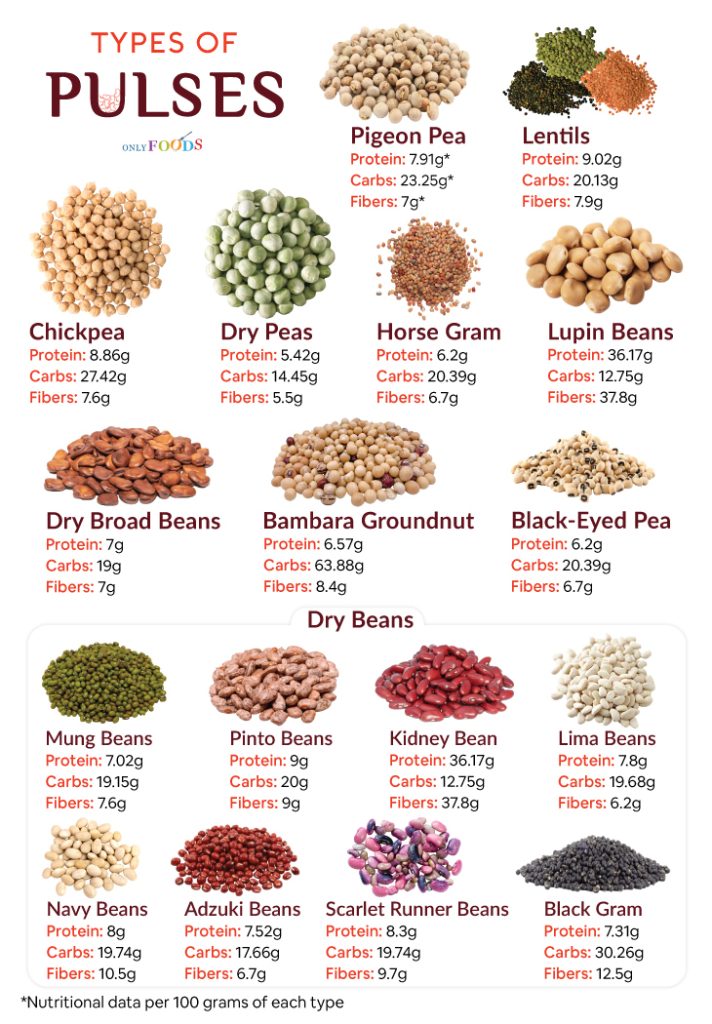Pulses
Pulses are legumes with seeds that can be dried and stored to be used as food. Like all legumes, pulses come from plants in the Fabaceae (Leguminosae) family. Chickpeas, lentils, and all types of beans are some of the most recognizable examples of pulses.
Going by the Food and Agriculture Organization (FAO) classification, the group does not include legumes, with their primary purpose being something other than dried food crops. So, oilseeds from the Fabaceae family, like soybeans and peanuts, are not considered pulses. The same goes for leguminous fruits and seeds eaten as fresh vegetables (green beans) and plants grown as forage (clover and alfalfa).
List of Different Types of Pulses
Pulses are famous for being some of the best protein sources, dietary fibers, essential vitamins, and minerals. A single portion of beans counts for one of your ‘5 a Day’ portions of vegetables and fruits in a day.
The average serving size is ¼ cup of raw pulses, which double and becomes ½ a cup when cooked. The exact weight varies depending on the type but usually ranges between 60-110 grams. So, adding a handful of soaked or boiled pulses to dishes like casseroles, salads, and stews adds to the dish’s nutritional value on top of improving its flavor and texture. Find out about the various types and how you could prepare
| Name | Protein/ 100g (cooked) | Carbohydrate/ 100g (cooked) | Fiber/ 100g (cooked) | Common Ways to Prepare |
|---|---|---|---|---|
| Dry Beans | Varies | Varies | Varies | Soaked and eaten both raw and cooked |
| — Mung Beans | 7.02g | 19.15g | 7.6g | Sprouted for salads, cooked in soups, curries, or stir-fried |
| — Lima Beans | 7.8g | 19.68g | 6.2g | Boiled or steamed, added to casseroles or succotash |
| — Pinto Beans | 9g | 20g | 9g | Boiled or refried, used in burritos, soups, and stews |
| — Kidney Beans | 8.67g | 22.8g | 6.4g | Boiled or canned, used in chili, salads, or rice dishes |
| — Navy Beans | 8g | 19.74g | 10.5g | Baked or boiled, used in soups, stews, and casseroles |
| — Adzuki Beans | 7.52g | 17.66g | 6.7g | Boiled, sweetened, and used in desserts or red bean paste |
| — Scarlet Runner Beans | 8.3g | 19.74g | 9.7g | Boiled, used in salads, or added to stews |
| — Black Gram | 7.31g | 30.26g | 12.5g | Used in Indian cuisine, particularly in dosas and idlis |
| Dry Broad Beans (Fava) | 7g | 19g | 7g | Boiled or pureed, used in Mediterranean and Middle Eastern cuisine |
| Dry Peas | 5.42g | 14.45g | 5.5g | Boiled, used in soups, stews, or mixed with rice |
| Chickpea (Garbanzo Beans) | 8.86g | 27.42g | 7.6g | Boiled or canned, used in salads, hummus, or curries |
| Black-Eyed Pea | 6.2g | 20.39g | 6.7g | Boiled, used in Southern dishes like Hoppin’ John |
| Pigeon Peas | 7.91g | 23.25g | 7g | Boiled, used in Indian, Caribbean, and African cuisines |
| Lentils | 9.02g | 20.13g | 7.9g | Boiled, used in various dishes globally |
| Lupin Beans | 36.17g | 12.75g | 37.8g | Soaked and boiled, used in salads or ground into flour |
| Horse Gram | 22.9g | 57.48g | 24.5g | Boiled, used in soups, stews, or sprouted in salads |
| Bambara Groundnut | 6.57g | 63.88g | 8.4g | Boiled, used in stews, porridge, or ground into flour |
The dried seeds from the following plants also fall in the group of pulses. However, they are not widely available, and though their seeds are suitable for human consumption, they need to be soaked and boiled in water multiple times to eliminate certain toxic elements they contain. These include:
- Winged (Dried seeds)
- Velvet bean (Dried seeds)
- Vetch
- Lablab
- Jack beans
- Sword Beans
Some of these, like vetch and lablab, are primarily used as livestock feed.
FAQ
As evident above, most pulses are rich in carbohydrates and fibers. So, indulging in large servings might not agree with everyone, leading to indigestion, gas, and bloating. Eating smaller servings less frequently might help if you experience such issues.

